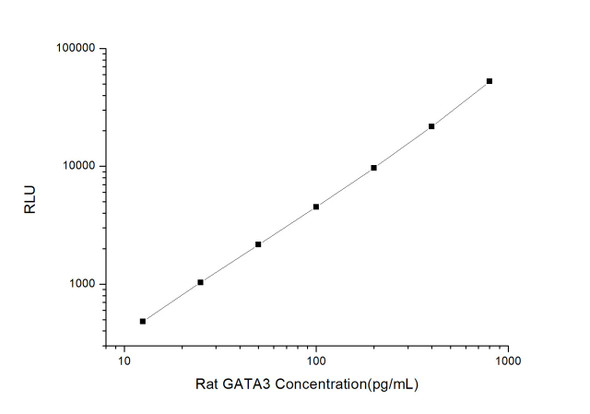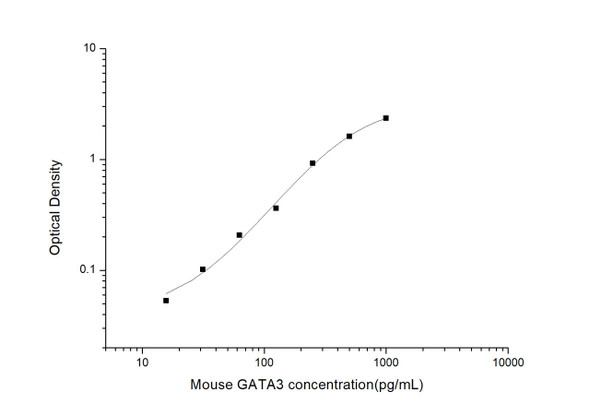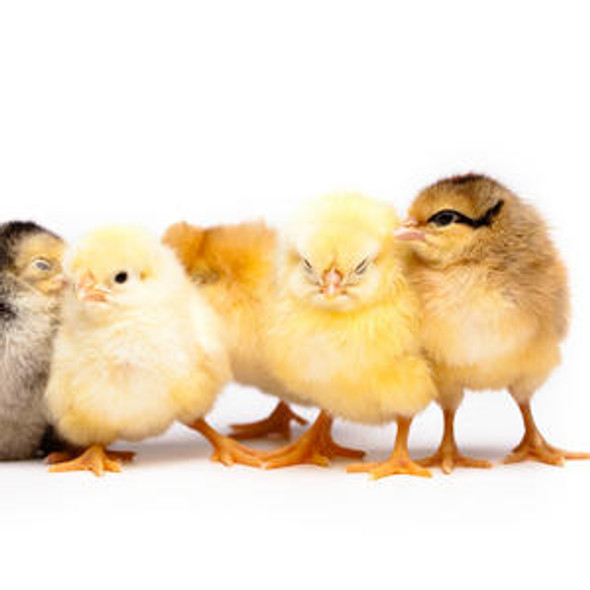Human Immunology ELISA Kits 1
Human GATA3 (GATA Binding Protein 3) CLIA Kit (HUES00530)
- SKU:
- HUES00530
- Product Type:
- ELISA Kit
- ELISA Type:
- CLIA Kit
- Size:
- 96 Assays
- Sensitivity:
- 37.5pg/mL
- Range:
- 62.5-4000pg/mL
- ELISA Type:
- Sandwich
- Synonyms:
- HDR, HDRS
- Reactivity:
- Human
- Sample Type:
- Serum, plasma and other biological fluids
- Research Area:
- Immunology
Description
| Assay type: | Sandwich |
| Format: | 96T |
| Assay time: | 4.5h |
| Reactivity: | Human |
| Detection method: | Chemiluminescence |
| Detection range: | 62.50-4000 pg/mL |
| Sensitivity: | 37.50 pg/mL |
| Sample volume: | 100µL |
| Sample type: | Serum, plasma and other biological fluids |
| Repeatability: | CV < 15% |
| Specificity: | This kit recognizes Human GATA3 in samples. No significant cross-reactivity or interference between Human GATA3 and analogues was observed. |
This kit uses Sandwich-CLIA as the method. The micro CLIA plate provided in this kit has been pre-coated with an antibody specific to Human GATA3. Standards or samples are added to the appropriate micro CLIA plate wells and combined with the specific antibody. Then a biotinylated detection antibody specific for Human GATA3 and Avidin-Horseradish Peroxidase (HRP) conjugate are added to each micro plate well successively and incubated. Free components are washed away. The substrate solution is added to each well. Only those wells that contain Human GATA3, biotinylated detection antibody and Avidin-HRP conjugate will appear fluorescence. The Relative light unit (RLU) value is measured spectrophotometrically by the Chemiluminescence immunoassay analyzer. The RLU value is positively associated with the concentration of Human GATA3. The concentration of Human GATA3 in the samples can be calculated by comparing the RLU of the samples to the standard curve.
| UniProt Protein Function: | GATA3: a transcriptional regulator central in Th2 cell differentiation. Inhibits breast cancer growth and pulmonary breast cancer metastasis. Represses INK4C transcription, constrains luminal progenitor cell expansion, and suppresses luminal tumorigenesis in the mammary gland. High GATA3 and low INK4C expression predicts a favorable patient outcome in luminal A type breast tumors. IFN-lambda1 (IL-29) inhibits GATA3 expression and suppresses Th2 responses in human T cells. GATA3 haploinsufficiency leads to HDR (hypoparathyroidism, deafness, and renal dysplasia) syndrome. Two alternatively spliced human isoforms have been described. |
| UniProt Protein Details: | Protein type:Transcription factor Chromosomal Location of Human Ortholog: 10p15 Cellular Component: nucleoplasm; nuclear chromatin; nucleolus; nucleus Molecular Function:protein dimerization activity; protein binding; DNA binding; zinc ion binding; interleukin-2 receptor binding; transcription coactivator activity; transcription factor binding; transcription factor activity Biological Process: developmental growth; positive regulation of transcription, DNA-dependent; cell maturation; ear development; cell fate determination; uterus development; T cell receptor signaling pathway; post-embryonic development; negative regulation of interleukin-2 production; norepinephrine biosynthetic process; regulation of neuron apoptosis; erythrocyte differentiation; anatomical structure formation; mesonephros development; kidney development; regulation of cytokine biosynthetic process; response to drug; thymic T cell selection; anatomical structure morphogenesis; inner ear morphogenesis; positive regulation of signal transduction; embryonic hemopoiesis; response to virus; negative regulation of fat cell differentiation; parathyroid gland development; negative regulation of mammary gland epithelial cell proliferation; response to ethanol; positive regulation of T cell differentiation; response to estrogen stimulus; positive regulation of transcription from RNA polymerase II promoter; pro-T cell differentiation; negative regulation of transcription, DNA-dependent; regulation of CD4-positive, alpha beta T cell differentiation; transcription from RNA polymerase II promoter; lens development in camera-type eye; axon guidance; phosphoinositide 3-kinase cascade; TOR signaling pathway; neuron migration; defense response; negative regulation of transcription from RNA polymerase II promoter; signal transduction; negative regulation of cell cycle; positive regulation of interleukin-4 production; negative regulation of cell proliferation; sympathetic nervous system development; negative regulation of interferon-gamma production; response to gamma radiation; type IV hypersensitivity; pharyngeal system development; thymus development; in utero embryonic development; male gonad development; humoral immune response; positive regulation of protein kinase B signaling cascade; negative regulation of inflammatory response; innate immune response; regulation of histone H3-K4 methylation; T-helper 2 cell differentiation; blood coagulation Disease: Hypoparathyroidism, Sensorineural Deafness, And Renal Disease |
| NCBI Summary: | This gene encodes a protein which belongs to the GATA family of transcription factors. The protein contains two GATA-type zinc fingers and is an important regulator of T-cell development and plays an important role in endothelial cell biology. Defects in this gene are the cause of hypoparathyroidism with sensorineural deafness and renal dysplasia. [provided by RefSeq, Nov 2009] |
| UniProt Code: | P23771 |
| NCBI GenInfo Identifier: | 120962 |
| NCBI Gene ID: | 2625 |
| NCBI Accession: | P23771. 1 |
| UniProt Secondary Accession: | P23771,Q5VWG7, Q5VWG8, Q96J16, |
| UniProt Related Accession: | P23771 |
| Molecular Weight: | 443 |
| NCBI Full Name: | Trans-acting T-cell-specific transcription factor GATA-3 |
| NCBI Synonym Full Names: | GATA binding protein 3 |
| NCBI Official Symbol: | GATA3 |
| NCBI Official Synonym Symbols: | HDR; HDRS |
| NCBI Protein Information: | trans-acting T-cell-specific transcription factor GATA-3; GATA-binding factor 3 |
| UniProt Protein Name: | Trans-acting T-cell-specific transcription factor GATA-3 |
| UniProt Synonym Protein Names: | GATA-binding factor 3 |
| Protein Family: | GATA-binding factor |
| UniProt Gene Name: | GATA3 |
| UniProt Entry Name: | GATA3_HUMAN |
As the RLU values of the standard curve may vary according to the conditions of the actual assay performance (e. g. operator, pipetting technique, washing technique or temperature effects), the operator should establish a standard curve for each test. Typical standard curve and data is provided below for reference only.
| Concentration (pg/mL) | RLU | Average | Corrected |
| 4000 | 56379 61783 | 59081 | 59046 |
| 2000 | 25259 30459 | 27859 | 27824 |
| 1000 | 13709 13259 | 13484 | 13449 |
| 500 | 6038 7172 | 6605 | 6570 |
| 250 | 3437 3049 | 3243 | 3208 |
| 125 | 1597 1565 | 1581 | 1546 |
| 62.50 | 715 795 | 755 | 720 |
| 0 | 34 36 | 35 | -- |
Precision
Intra-assay Precision (Precision within an assay): 3 samples with low, mid range and high level Human GATA3 were tested 20 times on one plate, respectively.
Inter-assay Precision (Precision between assays): 3 samples with low, mid range and high level Human GATA3 were tested on 3 different plates, 20 replicates in each plate.
| Intra-assay Precision | Inter-assay Precision | |||||
| Sample | 1 | 2 | 3 | 1 | 2 | 3 |
| n | 20 | 20 | 20 | 20 | 20 | 20 |
| Mean (pg/mL) | 185.12 | 568.83 | 1430.94 | 186.26 | 563.60 | 1531.82 |
| Standard deviation | 16.75 | 61.09 | 136.37 | 22.71 | 65.66 | 163.75 |
| C V (%) | 9.05 | 10.74 | 9.53 | 12.19 | 11.65 | 10.69 |
Recovery
The recovery of Human GATA3 spiked at three different levels in samples throughout the range of the assay was evaluated in various matrices.
| Sample Type | Range (%) | Average Recovery (%) |
| Serum (n=5) | 87-99 | 92 |
| EDTA plasma (n=5) | 95-108 | 102 |
| Cell culture media (n=5) | 85-99 | 92 |
Linearity
Samples were spiked with high concentrations of Human GATA3 and diluted with Reference Standard & Sample Diluent to produce samples with values within the range of the assay.
| Serum (n=5) | EDTA plasma (n=5) | Cell culture media (n=5) | ||
| 1:2 | Range (%) | 102-116 | 92-104 | 97-115 |
| Average (%) | 108 | 99 | 105 | |
| 1:4 | Range (%) | 86-99 | 102-116 | 88-105 |
| Average (%) | 92 | 110 | 96 | |
| 1:8 | Range (%) | 94-105 | 83-95 | 97-110 |
| Average (%) | 100 | 90 | 103 | |
| 1:16 | Range (%) | 90-106 | 93-106 | 101-119 |
| Average (%) | 97 | 101 | 109 |
An unopened kit can be stored at 4°C for 1 month. If the kit is not used within 1 month, store the items separately according to the following conditions once the kit is received.
| Item | Specifications | Storage |
| Micro CLIA Plate(Dismountable) | 8 wells ×12 strips | -20°C, 6 months |
| Reference Standard | 2 vials | |
| Concentrated Biotinylated Detection Ab (100×) | 1 vial, 120 µL | |
| Concentrated HRP Conjugate (100×) | 1 vial, 120 µL | -20°C(shading light), 6 months |
| Reference Standard & Sample Diluent | 1 vial, 20 mL | 4°C, 6 months |
| Biotinylated Detection Ab Diluent | 1 vial, 14 mL | |
| HRP Conjugate Diluent | 1 vial, 14 mL | |
| Concentrated Wash Buffer (25×) | 1 vial, 30 mL | |
| Substrate Reagent A | 1 vial, 5 mL | 4°C (shading light) |
| Substrate Reagent B | 1 vial, 5 mL | 4°C (shading light) |
| Plate Sealer | 5 pieces | |
| Product Description | 1 copy | |
| Certificate of Analysis | 1 copy |
- Set standard, test sample and control (zero) wells on the pre-coated plate and record theirpositions. It is recommended to measure each standard and sample in duplicate. Note: addall solutions to the bottom of the plate wells while avoiding contact with the well walls. Ensuresolutions do not foam when adding to the wells.
- Aliquot 100µl of standard solutions into the standard wells.
- Add 100µl of Sample / Standard dilution buffer into the control (zero) well.
- Add 100µl of properly diluted sample (serum, plasma, tissue homogenates and otherbiological fluids. ) into test sample wells.
- Cover the plate with the sealer provided in the kit and incubate for 90 min at 37°C.
- Aspirate the liquid from each well, do not wash. Immediately add 100µL of BiotinylatedDetection Ab working solution to each well. Cover the plate with a plate seal and gently mix. Incubate for 1 hour at 37°C.
- Aspirate or decant the solution from the plate and add 350µL of wash buffer to each welland incubate for 1-2 minutes at room temperature. Aspirate the solution from each well andclap the plate on absorbent filter paper to dry. Repeat this process 3 times. Note: a microplatewasher can be used in this step and other wash steps.
- Add 100µL of HRP Conjugate working solution to each well. Cover with a plate seal andincubate for 30 min at 37°C.
- Aspirate or decant the solution from each well. Repeat the wash process for five times asconducted in step 7.
- Add 100µL of Substrate mixture solution to each well. Cover with a new plate seal andincubate for no more than 5 min at 37°C. Protect the plate from light.
- Determine the RLU value of each well immediately.






